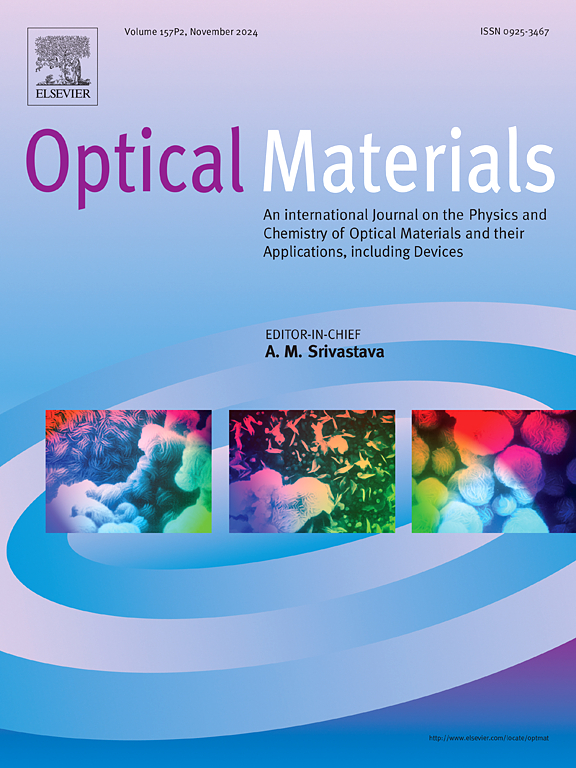掺锑氧化锡(ATO NPs)在不同 NMP 溶剂比中的最佳分散,以最大限度地提高碳基过氧化物太阳能电池的光电效率
IF 3.8
3区 材料科学
Q2 MATERIALS SCIENCE, MULTIDISCIPLINARY
引用次数: 0
摘要
本研究通过在氧化锡(SnO₂)中掺杂锑(12.9 % Sb/Sn),解决了过氧化锡(SnO₂)电子传输层(ETL)中的界面缺陷问题,用于制造过氧化锡太阳能电池(PSC)。采用扩散沉淀法,以不同比例的 N-甲基-2-吡咯烷酮(NMP)和蒸馏水(DW)为溶剂,形成了掺锑氧化锡(ATO)纳米粒子层,并沉积在 FTO 基底上。结构和成分分析(XPS、EDX 和 XRD)证实掺锑成功,保持了 SnO₂ 晶格并减小了颗粒尺寸。较高的 NMP 比率将导电率提高到 12 S/cm,增强了电荷传输,并将带隙从 3.67 eV 提高到 3.84 eV。在最佳的 100% NMP 条件下,基于 ATO 的 ETL 的功率转换效率 (PCE) 为 23.645%,填充因子 (FF) 为 43.681%,开路电压 (VOC) 为 1.202 V,短路电流密度 (JSC) 为 23.87 mA/cm2,这突显了 ATO 层在高性能 PSC 方面的潜力。本文章由计算机程序翻译,如有差异,请以英文原文为准。
Optimal dispersion of antimony-doped tin oxide (ATO NPs) in different NMP solvent ratios for maximizing photovoltaic efficiency of carbon-based perovskite solar cells
This study addresses interface defects in tin oxide (SnO₂) electron transport layers (ETLs) for perovskite solar cells (PSCs) by doping SnO₂ with antimony (12.9 % Sb/Sn). Using a diffusion-precipitation method with varying ratios of N-Methyl-2-Pyrrolidone (NMP) and distilled water (DW) as solvents, antimony-doped tin oxide (ATO) nanoparticle layers were formed and deposited on FTO substrates. Structural and compositional analyses (XPS, EDX, and XRD) confirmed successful Sb incorporation, maintaining the SnO₂ lattice with reduced particle size. Higher NMP ratios improved conductivity to 12 S/cm, enhanced charge transport, and raised the bandgap from 3.67 eV to 3.84 eV. Optimal 100 % NMP conditions yielded ATO-based ETLs achieving a power conversion efficiency (PCE) of 23.645 %, with a fill factor (FF) of 43.681 %, open-circuit voltage (VOC) of 1.202 V, and short-circuit current density (JSC) of 23.87 mA/cm2, underscoring the potential of ATO layers for high-performance PSCs.
求助全文
通过发布文献求助,成功后即可免费获取论文全文。
去求助
来源期刊

Optical Materials
工程技术-材料科学:综合
CiteScore
6.60
自引率
12.80%
发文量
1265
审稿时长
38 days
期刊介绍:
Optical Materials has an open access mirror journal Optical Materials: X, sharing the same aims and scope, editorial team, submission system and rigorous peer review.
The purpose of Optical Materials is to provide a means of communication and technology transfer between researchers who are interested in materials for potential device applications. The journal publishes original papers and review articles on the design, synthesis, characterisation and applications of optical materials.
OPTICAL MATERIALS focuses on:
• Optical Properties of Material Systems;
• The Materials Aspects of Optical Phenomena;
• The Materials Aspects of Devices and Applications.
Authors can submit separate research elements describing their data to Data in Brief and methods to Methods X.
 求助内容:
求助内容: 应助结果提醒方式:
应助结果提醒方式:


